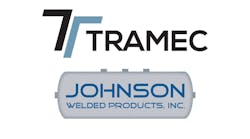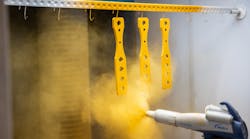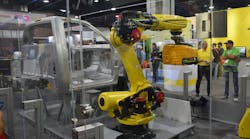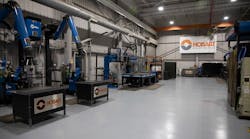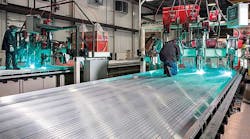When it comes to manufacturing truck bodies and trailers, aluminum is an ideal substrate, given its lighter weight, which transfers to fuel savings, and its high load-carrying capacity and corrosion resistance.
But welding aluminum, especially in long, continuous welds, demands special consideration, as does the requirement to join materials of varying thicknesses. These concerns add to the pile of familiar aluminum-welding challenges, including the material’s high thermal conductivity and low melting point, which can yield burnthrough, warping or lack of fusion.
The ability to perform difficult, repeatable aluminum welds quickly and reliably, while increasing productivity, is an important goal for truck body and trailer manufacturers. Fortunately, automation, combined with the right consumables for the job in automation-friendly packaging, offers answers.
Mechanized, or hard automation, i.e., “bug” and gantry systems, represents the most-common use of automation in trailer manufacturing. A bug—a carriage housing that moves along a pre-installed track—economically introduces automation into trailer applications, such as side-beam and stiffener welding. Simply mount a push-pull gun on the bug and away you go.
Gantry systems signify a major escalation in trailer welding automation. This increase in investment over bug systems delivers huge jumps in productivity. A typical example of use involves a gantry positioned over the trailer bed, capable of providing multiple welding arcs simultaneously, thus multiple welds in a pass, as the gantry traverses the bed. This approach is ideal for such applications as welding stiffeners.
In performing long welds, gantry systems upgrades can take advantage of an important automation component, seam tracking. The longer the weld, the less likelihood of proper fitup or of a straight seam line occurring all the way through. This is where seam tracking helps.
Seam-tracking systems use sensors, either mechanical or laser, to follow a seam and adjust the welding torch to maintain correct positioning, with cross-slides adjusting the arc to the seam during travel. The result? Faster, more accurate welds and efficiencies over the long haul in repetitive applications.
Robots reach out
Less common in the trailer industry, but of growing interest, are robotic arms, also referred to as flexible automation. Robotic systems today are not limited to small repetitive parts. In fact, robotic welding arms can be mounted to gantries and efficiently perform long welds. They also can be used to weld small parts or subassemblies to the trailer bed. Implementing flexible automation offers strong potential to dramatically increase output.
Improvements in communication between power sources and robots, in conjunction with sophisticated waveform technology, allow accurate joining of thick aluminum to thin.
A weave-waveform program where a higher output is applied to the thicker section and a lower output to the thinner section ensures ideal weld penetration. Other specialized waveforms include the use of low-frequency pulse welding to make outside trailer MIG welds appear aesthetically pleasing, similar to results from the TIG process. So, not only does technology allow for improved quality, but it also contributes to improved appearance.
Real-life example
When used correctly, flexible automation can pay off in tricky applications, such as a real-life instance when a manufacturer needed to install baffles in tank trailers. This process involved welding thicker aluminum extrusions to much thinner sheet. Welding challenges in this project revolved around fit-up of various aluminum parts and dealing with distortion across the longer welds.
Seam-tracking technology via a vision system allowed the manufacturer to achieve real-time joint tracking. Even if the joint strayed by a few millimeters, the robot could track accurately and place a small fillet weld all the way around the baffle. By controlling heat input, the automation solution addressed the challenge of differing part thicknesses and helped the manufacturer successfully complete the job.
In another flexible-automation application example, robots travel on a track between two stations to perform various welds on a rotating trailer bed in a headstock-tailstock. The weldment moves in coordination with the robotic arm, which itself moves to achieve ideal access to the joint and perform the ideal weld in the fastest amount of time. The robot controller manages multiple axes of rotation and coordinates these with the arm. Using the central controller, it’s easier to integrate the system, program from a single source and control weld schedules. With controllability, integration possibilities of robotic automation systems are many, and as technology progresses, more and more applications are possible.
Watch the wire
When welding aluminum, both mechanized and flexible automation benefit from the right wire, specifying proper wire feeding and packaging to ensure wire will feed seamlessly with the automation setup.
Bulk wire packaging is an excellent choice for gantry systems, and several options are available as to bulk package type. Be sure to consider wire placement and feedability when using this option. Large reel formats can provide improved wire placement, while a box design can provide easier changeovers.
Will you use feed-assist, push-pull or push-only? The solution depends both on the specified wire alloy automated-welding system design. In a hard-automation system, design is critical to successful wire feeding. Wire feed lengths, types of conduit used, conduit fittings and how you run the feed conduit are all important variables to consider.
Good feeding solutions exist for jobs that demand welding aluminum via flexible automation. Special welding torches with servo-motor feed drives located in the torch head, similar to push-pull guns, are ideal for feeding aluminum wire. Here, the servo motors are precision-controlled by the robots themselves. These torches enable special functions, such as wire retraction, to allow for accurate, fault-free starts. In addition, because the torches use a servo motor, they can be controlled very precisely by the robotic controller, allowing advantages such as more precise crater fill.
Cutting changeover time
Bulk packaging in mechanized- and flexible-automation welding systems reduces changeover time and maximizes arc-on time. Bulk aluminum-wire packages, such as the Gem-Pak from Lincoln Electric, feature little resistance on the wire, thus allowing for tangle-free feeding while eliminating shaving.
Another option, reel packages, deliver improved wire placement but typically require auxiliary equipment, such as dynamic de-reelers or mechanized feed assists. Again, packaging should be addressed when designing the cell, not as an afterthought.
For gantry welding systems, bulk packaging must be built in into the weight capacity of the gantry, with the packaging footprint considered, as well.
It is important to work with an automation integrator who can design a complete system, including the components used, the feeding method and all related challenges. Even in regard to developing weld schedules, using wire specifically designed for trailer manufacturers, such as SuperGlaze 5356TM from Lincoln Electric, can help maximize travel speed and cycle times.
With the right combination of automation, wire, feed and wire-packaging technologies, trailer manufacturers can find a welding system to fit their needs.
Michael Morgan is general manager for Lincoln Electric Automation Solutions of Canada, Mississauga, Ontario, Canada; and Gregory D. Doria is US. West region sales manager, Santa Fe Springs, CA; www.lincolnelectric.com/alum.
